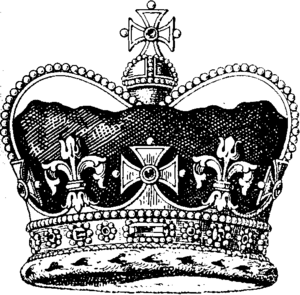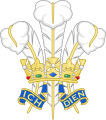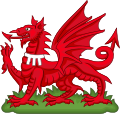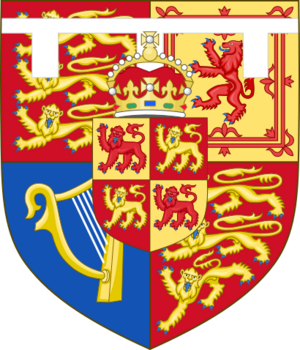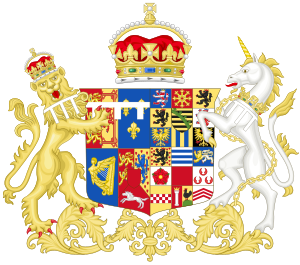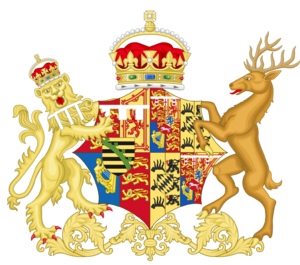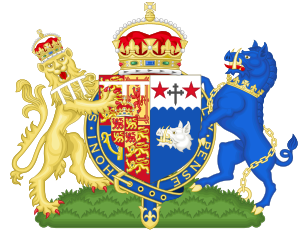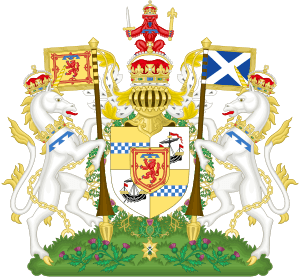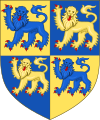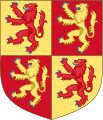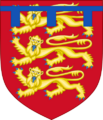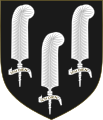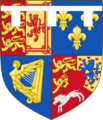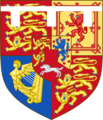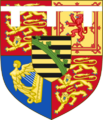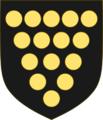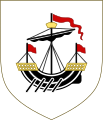Coat of arms of the Prince of Wales facts for kids
Quick facts for kids Coat of arms of the Prince of Wales |
|
|---|---|
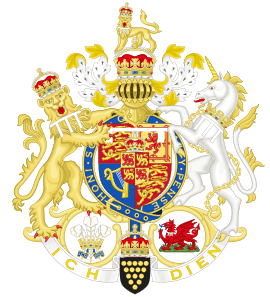 |
|
| Versions | |
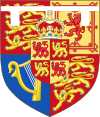
Escutcheon of the Prince of Wales
|
|
| Armiger | William, Prince of Wales |
| Crest | The royal crest of England differenced with a label of three points argent but with the coronets those of the heir apparent; gold and ermine mantling |
| Blazon | The Royal Arms differenced by a label of three points argent overall an inescutcheon quarterly gules and or, four lions passant guardant counterchanged (for the Principality of Wales / Llywelyn the Great ensigned by the coronet of his degree) |
| Supporters | A golden lion, wearing the coronet of the Heir apparent, and a silver unicorn, both differenced with a white label of three points |
| Motto | German: Ich dien ("I Serve") |
| Order(s) | Order of the Garter |
| Badge |
|
The coat of arms of the Prince of Wales is a special symbol or badge for the Prince of Wales. This important title is usually given to the person who is next in line to become the King or Queen of the United Kingdom. It's a bit like a family crest, but for the royal family!
The coat of arms used by Charles III when he was Prince of Wales was created in 1958. It included symbols from all four parts of the United Kingdom. These arms changed when Charles became King.
Since Edward I of England in the 1200s, the person next in line to the English (and later British) throne has been given the title Prince of Wales. William received this title from his father, Charles III, soon after Charles became King.
The history of this coat of arms is closely connected to the Royal Arms of the United Kingdom. However, it has its own unique features.
Contents
What Symbols Are on the Coat of Arms?
The Prince of Wales's coat of arms has several important parts. Each part tells a story about his role and history.
The Coronet
The coronet is a small crown that sits on top of the shield. In 1661, King Charles II of England decided what the Prince of Wales's coronet should look like. It has crosses and fleur-de-lis (a lily symbol), with one arch going over the top. It also has a ball and a cross at the very top.
This coronet shows that the Prince is the eldest son of the King or Queen. It's not just for being the Prince of Wales. The Prince's wife, the Princess of Wales, also uses this coronet in her own coat of arms.
The Label
A "label" is a special band placed across the top of the shield. It has three points hanging down. This label is used to show that these arms belong to the heir, not the King himself. It helps to tell their coats of arms apart.
Since Edward the Black Prince in the 1300s, the Prince of Wales has used a white or silver label with three points. This has been a tradition ever since.
The Crest
The crest is the part that sits on top of the helmet in the coat of arms. The Prince of Wales's crest is similar to the King's. It shows a golden lion walking and looking forward. This lion wears the special coronet of the heir. It also has the three-point white label on its shoulders.
The lion stands on a larger coronet, which then sits on a golden helmet. Gold and ermine (a type of fur pattern) fabric flows from the sides.
The Supporters
The supporters are the animals that stand on either side of the shield. The Prince of Wales uses the same supporters as the King: a lion and a unicorn. Both animals have the Prince's white label around their necks.
The golden lion on the right side is an old symbol of England. It wears the heir's coronet. The white unicorn on the left side represents Scotland. It was added to the royal arms after Scotland and England joined in 1603.
The Order of the Garter
Prince William became a Knight of the Garter in 2008. Most Princes of Wales have joined this important order since it began in 1348.
The Order of the Garter is shown on the coat of arms by a blue buckled garter. It has the motto Honi soit qui mal y pense written on it in gold letters. This French phrase means "Shame on him who thinks evil of it."
The Motto
Below the coat of arms, there is a scroll with the motto Ich dien. This is German for "I serve." This motto first appeared on the arms of Edward the Black Prince in the 1300s.
Legend says the Black Prince took this motto and the ostrich feathers from John of Bohemia, who died fighting alongside the Prince in a battle in 1346. The motto also sounds like "Your Man" in Welsh.
Special Badges
The Prince of Wales also has several special badges. These badges show his history and the different titles he holds.
Prince of Wales's Feathers
The Prince of Wales's feathers badge is very famous. It shows three ostrich feathers. They are white and have a royal coronet around them. The motto Ich dien is on a dark blue ribbon below the feathers.
This badge is probably the most recognized symbol of the Prince of Wales. It is also a symbol of Wales itself. Companies that regularly supply goods or services to the Prince can display this badge. As of 2018, 170 companies were allowed to use it. Many Welsh groups, like army regiments and the Welsh Rugby Union, also use this badge.
Feathers have been an old royal symbol for a long time. But they became a regular part of the Prince of Wales's arms after the Black Prince used them.
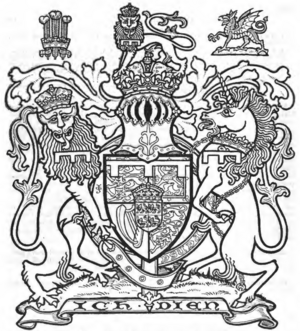
Red Dragon of Wales
In 1901, King Edward VII added the Red Dragon badge to the Prince of Wales's coat of arms. This dragon is shown walking on a green hill and is red. It also has the three-point white label. It was added to go with the feathers badge.
The Red Dragon, or Y Ddraig Goch, has been a symbol of Wales since the 600s. It became a royal badge for the kings of England when Henry Tudor used it on his battle flag. In 1801, the red dragon became an official royal badge for Wales.
Arms of the Duchy of Cornwall
The arms of the Duchy of Cornwall are black with fifteen gold circles. These circles are called "bezants." They come from the arms of Richard of Cornwall from the 1200s.
When Elizabeth II became Queen in 1952, her son Charles automatically became the Duke of Cornwall. This meant he could show the Duchy's arms on his coat of arms. This title has been given to every heir to the throne since 1337. In 1968, two Cornish choughs (birds) were added as supporters to these arms. The motto "Houmont" (meaning courage) was also added.
-
The Prince of Wales's feathers badge
-
The red Welsh dragon badge with a label of three points
The Shield (Escutcheon) History
The main shield, or escutcheon, on the Prince of Wales's coat of arms has changed over time. It reflects the history of both Welsh princes and the English/British heirs.
Early Welsh Princes
Before Wales was fully joined with England, independent Welsh princes had their own arms. For example, Llywelyn ap Gruffudd used a shield with four lions. Later, Owain Glyndŵr, who led a Welsh revolt, also had a shield with four lions.
English and British Heirs
When the English throne began creating Princes of Wales, their arms usually showed the Royal Arms of England with a special "label" to show they were the heir.
- Edward II (early 1300s): His arms were the King's arms with a blue label.
- Edward the Black Prince (mid-1300s): He used the King's arms (which then included symbols for France) with a white label. He also had a special "Shield for Peace" with three ostrich feathers and the motto "Ich Dien."
- Later Princes (1399-1547): The arms changed to match the Royal Arms, which updated to show a different French symbol.
- Stuart Princes (1610-1688): When the Scottish royal family took the English throne, the arms changed to include symbols for Scotland and Ireland.
- Hanoverian Princes (1714-1801): The arms changed again to include symbols for the German lands of Hanover, where the new royal family came from.
- George IV (1801-1820): After the Act of Union in 1800, the claim to France was dropped. The Hanoverian symbols moved to a small shield in the center.
- Victorian Era Princes (1841-1910): When Queen Victoria became Queen, the Hanoverian shield was removed. A small shield with the arms of Saxony (from her husband's family) was added for her male descendants.
- Modern Princes (1911-present): In 1911, King George V changed the arms again. The Saxony shield was replaced with a shield showing the arms of the Principality of Wales. This shield has four lions, just like the old Welsh princes' arms. This is the version used by Charles III when he was Prince of Wales, and it is expected to be used by Prince William.
The Prince's Family
Princess of Wales
The wife of the Prince of Wales is called the Princess of Wales. She also gets her own special coat of arms when she marries. Her arms combine her husband's arms with her own family's arms. She can also use the Prince's supporters and coronet.
Catherine, the current Princess of Wales, received her coat of arms when she married William, Prince of Wales in 2011.
| Augusta of Saxe-Gotha-Altenburg (wife of Frederick, 1736 – 1772) |
Alexandra of Denmark (wife of Albert Edward, 1863 – 1901) |
Mary of Teck (wife of George, 1901 – 1910) |
| Diana Spencer (wife of Charles, 1981 – 1996) |
Camilla Shand (wife of Charles, 2005 – 2022) |
Other Arms of the Prince
The Prince of Wales holds other important titles, each with its own coat of arms.
| Coat of arms of the Duchy of Cornwall (as updated in 1968) |
Coat of arms of the Duke of Rothesay (in Scotland) |
Images for kids
-
Arms of Llywelyn ap Gruffudd, an early Welsh prince
-
Arms of Dafydd ap Gruffydd, the last independent Prince of Wales
-
Arms of Owain Glyndŵr, who led a Welsh revolt
-
Arms of Edward II of England as Prince of Wales
-
Arms of Edward the Black Prince (Shield for War)
-
Arms of Edward the Black Prince (Shield for Peace)
-
Arms of the Earl of Chester
-
Arms of the Duke of Rothesay
-
Arms of the Earl of Carrick
-
Arms of the Lord of the Isles
See also
- Coat of arms of the United Kingdom
- Coat of arms of Scotland
- Royal Badge of Wales
- Prince of Wales
- Duke of Rothesay
- Duke of Cornwall
Links
- Titles and Heraldry at the Official website of the Prince of Wales


